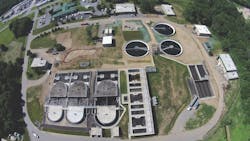Casey Whittier is BioMag and CoMag systems product manager for Evoqua. Whittier can be reached at [email protected].
Lessons can be learned from how a wastewater treatment plant (WWTP) in Maryland saved millions in expenses while increasing treatment capacity and complying with strict effluent limits to protect aquatic life in the Chesapeake Bay. The project included the world’s first ballasted biological system in an oxidation ditch.
The WWTP & Effluent Discharge at a Glance
The Conococheague WWTP is the largest of seven wastewater treatment facilities serving Washington County, Maryland. This WWTP receives domestic wastewater from the Washington County sewer system and pretreatment effluent from the Conococheague Industrial Pretreatment Facility (CIPF), the county’s designated facility for treating wastewater from septic tanks, holding tanks, and chemical toilets.
Treated effluent flows from the Conococheague WWTP into the Conococheague Creek, which is discharged into the Upper Potomac River and the Chesapeake Bay.
The Challenge
Since fish and other wildlife depend on the Chesapeake Bay watershed, the state of Maryland implemented the Chesapeake Bay Initiative. It aims to reduce pollutants in the bay, such as nitrogen and phosphorus, by 25% by the year 2025.
To comply with the increasingly strict nutrient removal limits, the Conococheague WWTP needed technology to better treat its wastewater. It had to meet effluent performance equal to or less than 0.3 mg/L total phosphorous (TP) as phosphorus and 10 mg/L total suspended solids (TSS).
The WWTP also needed to expand its existing bioreactors to provide additional treatment capacity for higher loading rates. But limited available land posed another challenge, which led to one glaring question: could the WWTP repurpose old equipment by incorporating modern technology?
Ballasted Activated Sludge
The original WWTP consisted of influent mechanical bar screening, grit removal, two oxidation ditches, two secondary clarifiers, tertiary sand filtration, ultraviolet disinfection, sludge holding tanks and belt press for solids thickening.
The BioMag ballasted activated sludge process by Evoqua Water Technologies was chosen for the Conococheague plant. The enhanced nutrient removal (ENR) upgrade added influent fine screening, the BioMag system, a third secondary clarifier, three post anoxic tanks, cascade post aeration, aerobic digestion and centrifugal solids separation.
Evoqua worked with RK&K, a consulting engineering firm, to develop a solution to retrofit the existing single-stage system into a four-stage Bardenpho oxidation ditch with ENR capabilities.
The BioMag system enhances biological wastewater treatment processes with magnetite (Fe3O4) to ballast biological floc. Magnetite substantially increases the settling rate of the biomass, providing opportunity to increase mixed liquor suspended solids (MLSS) concentration, which enables more treatment capacity within the same tank.
With the BioMag system in place, the existing tertiary sand filtration no longer was needed to meet ENR effluent treatment levels, so it was taken offline.
Treatment Train Overview
The facility consists of three treatment trains, each train consisting of a pre-anoxic zone, an aerobic zone, a post-anoxic zone, and a re-aeration zone. The pre-anoxic zone in each train has two top entry mixers. Each aeration zone has two mechanical aerators, two annular mixers and one center wall submersible mixer. The post-anoxic zone in each train contains two top entry mixers. The re-aeration zone contains coarse bubble aeration.
The BioMag system is fully automated and controlled by a PLC-equipped control panel.
Magnetite Recovery
The magnetite recovery system at the Conococheague WWTP consists of three magnetite recovery drums (mag drums), three shear mills and one sludge screen.
Waste activated sludge (WAS) is pumped from the clarifier to the shear mill. This is where the biological floc is sheared apart and the magnetite is separated by imparting mechanical energy. The biological floc WAS then flows to the mag drum, which separates magnetite from biological solids. This process is accomplished by permanent magnets mounted inside the rotating mag drum. The WAS is discharged to the plant’s waste solids handling process.
Recovered magnetite flows into a magnetite conveyance channel, which is fed with about 200 gallons per minute of return activated sludge (RAS) flow. It then discharges to the ballast mix tank.
Magnetite Feed
Conococheague WWTP’s magnetite feed system consists of a magnetite silo, a pneumatic feeder, a compressed air system feeding the pneumatic feeder and the ballast mix tank. In addition to the recovered magnetite, the ballast mix tank receives virgin magnetite from a 25-ton silo. Magnetite from the silo is conveyed to the ballast mix tank by a pneumatic feed system.
The ballast mix tank provides retention time and mechanical energy (from the mixer installed in the tank), allowing recovered and raw magnetite to embed within the biological floc. Ballasted mixed liquor is pumped from the ballast mix tank to the aeration basins.
The plant uses alum with single point addition prior to secondary clarifier splitter box to remove a bulk of the soluble phosphorus. The plant also adds polymer to enhance flocculation by injecting it into the clarifier splitter box.
Reviewing the Performance
The ENR upgrade, in conjunction with the addition of the BioMag system, has allowed the WWTP to achieve stringent effluent limits—without the need for effluent filters or tertiary treatment. It offers stable operation across a wide range of flows.
Using this settling clarification technology for biological floc, the system allowed for capacity expansion and performance improvement with minimal plant modifications. The BioMag system produced excellent effluent, despite flow rates greater than the design monthly average of 4.6 million gallons per day (mgd). The system provides up to 300% more treatment capacity in existing tanks.
Evoqua completed a process performance test (PPG) between July and September 2018. During this timeframe, the plant treated an average of 4.14 mgd, about 90% of the ENR upgrade design plant influent flow rate. The PPG proved the BioMag system met the effluent performance conditions of 0.3 mg/L TP (as P) and 10 mg/L TSS.
TP, TSS, and total nitrogen (TN) concentrations have all been within permit limits. A majority of the TP measurements were below the level of detection. Effluent TN treatment also improved significantly after the WWTP system startup. A combination of factors contributed to this development, including:
- Bringing new post anoxic tanks online in all three trains;
- Optimizing the oxidation ditch system for denitrification; and
- Increasing the biological mixed liquor suspended solids to ensure the plant maintained nitrification even during the coldest months of the year.
The Conococheague plant successfully passed the performance test, achieving an average effluent total phosphorus concentration of 0.27 mg/L and TSS concentration of 2 mg/L over the three-month test period. (Alum was the coagulant used during testing period. The chemical was provided and controlled by others.)
By integrating the BioMag system into the existing oxidation ditches at Conococheague WWTP, the existing infrastructure could be used to meet stringent ENR discharge limits. This has resulted in significant project cost savings for the county.
“Washington County is saving approximately $16 million by purchasing BioMag systems,” said Julie Pippel, director of the county’s Division of Environmental Management. “It is much more cost effective to reuse existing infrastructure with the BioMag System, rather than incurring the expense of building an all-new
treatment plant.”



